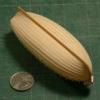-
Posts
13,313 -
Joined
-
Last visited
Content Type
Profiles
Forums
Gallery
Events
Everything posted by druxey
-

Gantry style building board dimensions advice
druxey replied to davec's topic in Modeling tools and Workshop Equipment
Have you considered MDF (medium density fibreboard)? It is flat and warp-free. -

Gantry style building board dimensions advice
druxey replied to davec's topic in Modeling tools and Workshop Equipment
Gesso fills grain and levels uneven surfaces. After several coats that have been applied and sanded, the surface is as smooth as one might wish. -
Well done, shrimp. To finish your first model is an accomplishment in itself. You did a nice job of those oars as well. Now you can build on those foundational skills.
- 12 replies
-
- Lowell Grand Banks Dory
- first build
-
(and 1 more)
Tagged with:
-

Gantry style building board dimensions advice
druxey replied to davec's topic in Modeling tools and Workshop Equipment
I'd really question the need for melamine. I use either ⅝" or ¾" quality ply with several coats of gesso, well sanded between coats, to provide a level surface that will easily take pencil marks. (Gesso both sides to prevent warping.) The board is stabilised from beneath with two inset longitudinal 1 x 2 pine boards on edge, well screwed down. -

HMS ANSON 1781 by albert - 1/48 - 64 guns
druxey replied to albert's topic in - Build logs for subjects built 1751 - 1800
It's always good to see your progress; the work of someone who knows exactly what he's doing. Lovely! -
If you are referring to the standard, it usually had the gammoning slot on its underside. It was firmly bolted through the knee of the head and was certainly strong enough to resist upward forces from the gammoning and bowsprit. Remember that there were also bobstays to reduce this load. The standard is rarely shown in the 'as built' sheer plan.
-
Your attention to detail is astonishing! If you want to try gold leaf again, there is a new system that i used recently and works like a charm. No waiting for the right amount of 'tack' for oil gilding or messing with rabbitskin glue for water gilding. It's called Kölner Instacoll and made in your country - Germany! It's in two parts, water based. Check it out.
-

Yellow and Yellow Ochre
druxey replied to Fishooks's topic in Painting, finishing and weathering products and techniques
Generally earth pigment paints are not high in chroma (bright and intense in color). Also impurities in the pigments used would dull the color as well. So, your suspicion that bright yellow on a period model is incorrect is very justified! The other factor to consider is the effect of distance and scale. The further one is from an object, the more the color sees to be leached out and, in the far distance, bluer. The smaller the scale of your model, the colors should be more diluted, as it were, so that the model does not look toy-like. -
Another well-done reconstruction. Terrific, Steven!
- 508 replies
-
To cast your own cannon you will need to learn how to make RTV (room-temperature vulcanising) rubber mold from a master pattern. Alternatively, you could build up the missing cascabel with a modeling compound and panit the completed cannon. Another route woudl be to buy quality resin-cast or 3D printed pieces.
About us
Modelshipworld - Advancing Ship Modeling through Research
SSL Secured
Your security is important for us so this Website is SSL-Secured
NRG Mailing Address
Nautical Research Guild
237 South Lincoln Street
Westmont IL, 60559-1917
Model Ship World ® and the MSW logo are Registered Trademarks, and belong to the Nautical Research Guild (United States Patent and Trademark Office: No. 6,929,264 & No. 6,929,274, registered Dec. 20, 2022)
Helpful Links
About the NRG
If you enjoy building ship models that are historically accurate as well as beautiful, then The Nautical Research Guild (NRG) is just right for you.
The Guild is a non-profit educational organization whose mission is to “Advance Ship Modeling Through Research”. We provide support to our members in their efforts to raise the quality of their model ships.
The Nautical Research Guild has published our world-renowned quarterly magazine, The Nautical Research Journal, since 1955. The pages of the Journal are full of articles by accomplished ship modelers who show you how they create those exquisite details on their models, and by maritime historians who show you the correct details to build. The Journal is available in both print and digital editions. Go to the NRG web site (www.thenrg.org) to download a complimentary digital copy of the Journal. The NRG also publishes plan sets, books and compilations of back issues of the Journal and the former Ships in Scale and Model Ship Builder magazines.



